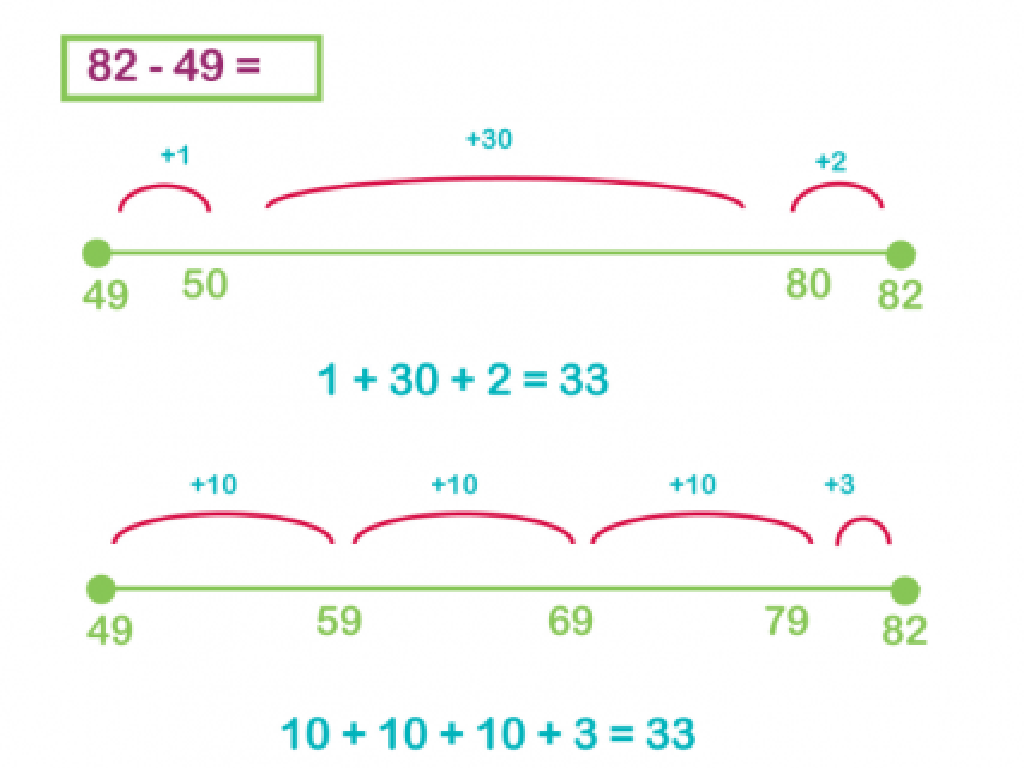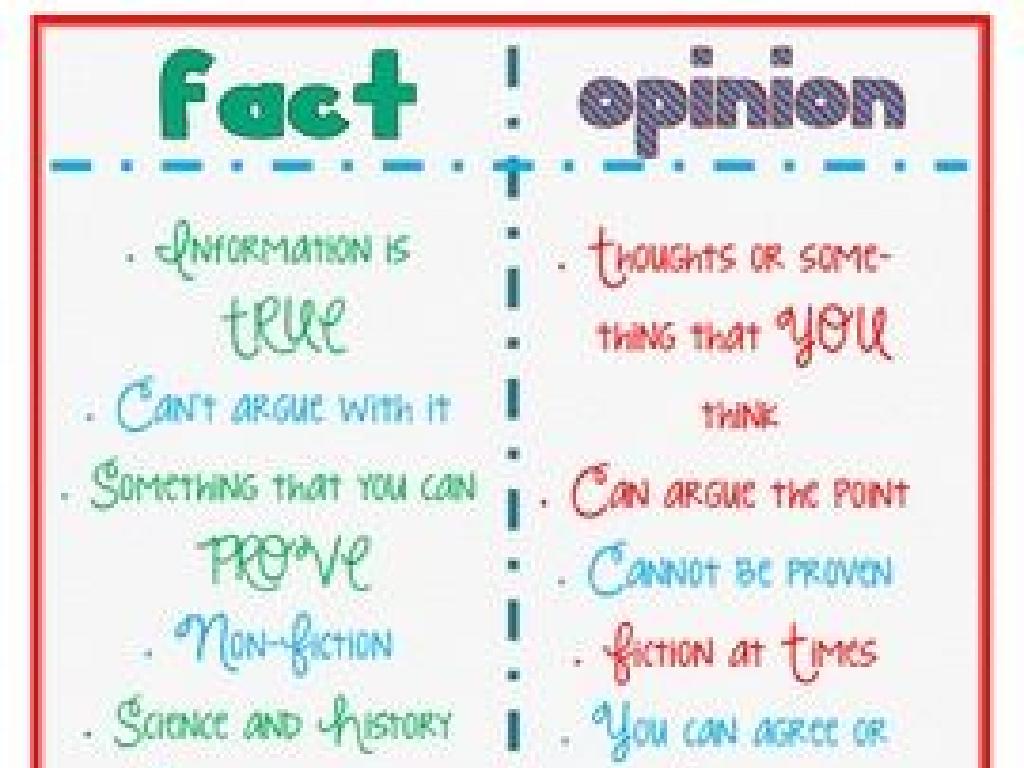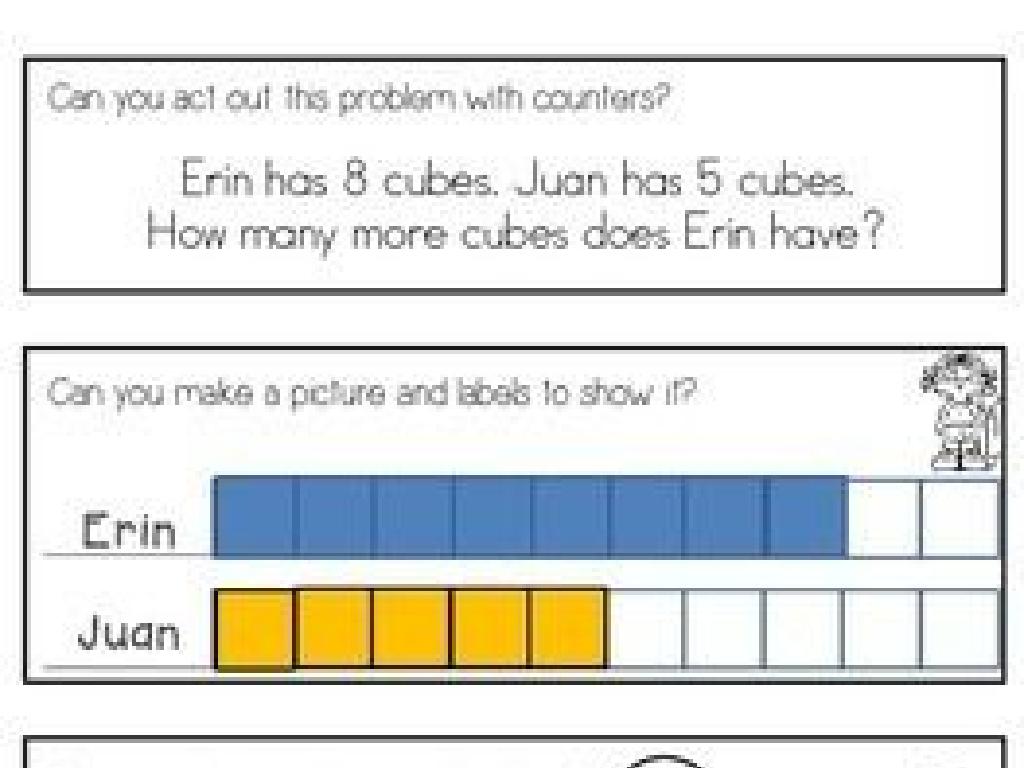Add Doubles - With Models
Subject: Math
Grade: First grade
Topic: Addition Strategies Up To 20
Please LOG IN to download the presentation. Access is available to registered users only.
View More Content
Welcome to Addition: Add Doubles with Models
– Learn a fun way to add numbers
– What are ‘Add Doubles’?
– ‘Add Doubles’ means adding two same numbers
– Using models to understand doubles
– Use objects like blocks or fingers to see doubles
– Practice to become addition experts
|
This slide introduces first graders to the concept of ‘Add Doubles’ as a strategy for addition. Start by engaging the students with the idea that adding numbers can be fun. Explain that ‘Add Doubles’ is simply adding two of the same numbers together, such as 2+2 or 5+5. Demonstrate this concept using visual models like blocks, drawings, or fingers to help them visualize the concept. Encourage the students to practice this strategy with different numbers to become confident in their addition skills. The goal is for them to recognize patterns in adding doubles and use this knowledge to solve addition problems quickly.
Understanding Doubles in Addition
– What are doubles?
– Two identical numbers added together
– Examples of doubles
– Like 1+1=2, 2+2=4, 3+3=6
– Counting in pairs
– Group objects in two to count
– Visualizing doubles with objects
– Use items like blocks or stickers to see doubles
|
This slide introduces the concept of doubles in addition, which is a foundational math skill for first graders. Begin by explaining that doubles are simply two of the same number added together. Provide clear examples using small numbers that are easy for the students to understand and visualize. Encourage the students to count objects in pairs to reinforce the concept of doubles. For instance, use physical items such as blocks, counters, or stickers to help them see the concept in action. This hands-on activity will help solidify their understanding of doubles as they prepare to use this strategy in more complex addition problems.
Adding Doubles with Blocks
– Use blocks to show doubles
– Example: Adding 2+2 with blocks
– Imagine 2 red blocks and 2 blue blocks, then combine them
– Let’s solve doubles together
– We’ll add 1+1, 2+2, 3+3, and so on using blocks
– Practice makes perfect
|
This slide introduces the concept of adding doubles using a hands-on approach with blocks, which helps to visualize the concept for first-grade students. Start by explaining that doubles are two groups of the same number. Show them how to physically combine two sets of blocks to find the sum. Encourage participation by having students work out several examples with their own sets of blocks. This activity will help solidify their understanding of addition and doubles. As a teacher, be prepared to walk around the classroom to assist and ensure that students are correctly pairing the blocks. Offer praise for effort and correct answers to build confidence.
Doubles Addition Chart
– Chart of doubles up to 10+10
– Shows pairs from 1+1 to 10+10
– Quick answers with the chart
– Helps us add faster without counting each time
– Look for patterns in doubles
– Do the sums get bigger by the same amount?
|
This slide introduces students to a visual doubles addition chart, which includes all double addition facts up to 10+10. The chart is a tool to help students quickly find the answers to doubles without having to count each time. Encourage the students to observe any patterns they can find in the chart, such as the sums increasing by 2 each time. This observation can help them understand the concept of doubles and how each consecutive double is just adding 2 more to the previous sum. Use this opportunity to reinforce the idea that patterns can make math easier and more fun. During the class, ask students to point out the patterns they see and explain why they think those patterns occur.
Practice Time: Adding Doubles
– Let’s practice with examples
– We’ll solve problems as a class
– I’ll write a problem, and we solve it together
– Use your doubles chart
– Your chart has all the doubles up to 10+10
– Remember, practice makes perfect!
|
This slide is designed to engage students in a group activity to reinforce the concept of adding doubles. Start by explaining that adding doubles means adding the same number to itself, like 2+2 or 5+5. Encourage the students to use their doubles chart as a visual aid. Write a few examples on the board, such as 3+3 or 6+6, and solve them together, ensuring that each student participates and understands the process. Remind them that the more they practice, the better they’ll get at recognizing and adding doubles quickly. For the activity, consider pairing students up to practice or creating a fun game where they can ‘race’ to find the sum of doubles.
Add Doubles with a Story
– Listen to a doubles story
– I’ll tell a tale with pairs of things
– Find the doubles as we go
– Keep an ear out for matching items
– We’ll add the doubles together
– Use your fingers or drawings to add
– Practice with your own story!
– Create a doubles story and share it
|
This slide is designed to engage first-grade students in learning to add doubles through storytelling. As you tell the story, emphasize the pairs of items that appear, and encourage students to listen closely and identify these doubles. After the story, work together as a class to add up the doubles that were found, using visual aids like fingers or drawings to help them visualize the concept. Finally, encourage students to create and share their own stories involving doubles to reinforce their understanding and make the learning process interactive and fun.
Class Activity: Doubles Bingo!
– Let’s play Doubles Bingo
– Listen for doubles facts
– Like 2+2, 3+3, 4+4, and so on
– Cover the answer on your card
– Use counters to cover the numbers
– Shout ‘Bingo!’ for a full row
|
This interactive game is designed to help first graders practice and reinforce their understanding of addition doubles. Prepare bingo cards in advance with answers to doubles facts up to 10 (e.g., 4, 6, 8, 10, etc.). During the game, call out addition doubles, and students will place markers on the corresponding answers. This activity not only makes learning fun but also encourages quick recall of addition facts. Possible variations of the game could include using different bingo patterns or having students create their own bingo cards with doubles facts. Ensure that all students understand the rules and the concept of ‘doubles’ before starting the game.
Conclusion: Mastering Doubles Addition
– Celebrate learning about doubles!
– Practice is key to perfection
– Use your doubles chart daily
– A chart with pairs of numbers 1+1, 2+2, etc.
– Keep practicing at home
|
As we wrap up our lesson on adding doubles, it’s important to acknowledge the students’ hard work and progress. Reinforce the idea that becoming proficient with doubles addition is a matter of consistent practice. Encourage them to use the doubles chart they’ve been provided as a daily exercise to help commit these sums to memory. Remind them that practice can be fun and suggest incorporating it into daily routines, such as counting steps in twos or adding up toys in pairs. The goal is to make adding doubles a reflexive skill, which will greatly benefit their future math endeavors.






